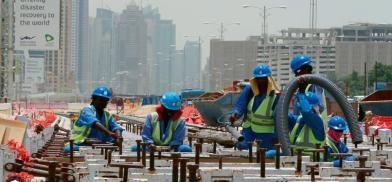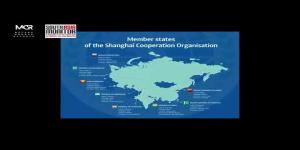The Indian Migrant in the Middle East: Between Institutional and Climate Insecurities
The question must be asked: has the Middle Eastern dream become an Indian nightmare? Migrant workers face compounding insecurities, with the confiscation of passports turning them into virtual hostages. Structural exploitation, poor working conditions, and the intensifying climate crisis disproportionately impact Indian migrants—many of whom are semi- or unskilled laborers from already vulnerable communities.

The Government of India estimates that nearly 90 percent of Indian labor migrants head to the Middle East, contributing to 40 percent of India’s foreign remittances—the lion’s share. Although South Asians comprise almost half of all migrant labor in the region, their living conditions are often deplorable. Most reside in isolated labor camps, far from urban centers, with greater exposure to the adversities of climate change.
Institutional Insecurities
Migration from India to the Middle East reflects structural issues in both the country of origin and the destination. Pushed by unemployment and pulled by high demand for low-cost, semi- and unskilled labor, the number of Indian migrant workers in the Gulf has increased by 79 percent over the past two decades. However, these workers are paid far less than local employees, and most Gulf nations lack enforceable legislation on minimum wages or labor conditions to protect them. Many face delayed or denied wages.
The absence of institutional safeguards is compounded by systemic social exclusion. Children of migrant workers are often barred from attending government schools, while public spaces like malls unofficially discourage their presence. In several Gulf cities, single men—especially South Asians—are prohibited from living in residential areas meant for families.
Labor camps, where migrants live, are overcrowded and lack basic amenities such as clean water, sanitation, and reliable transportation. These workers are also exposed to extreme weather conditions, frequently suffering from heatstroke or workplace injuries. Other common issues include non-payment of wages, denial of labor rights and benefits, lack of residence permits or their renewal, refusal of overtime, and the absence of weekly holidays.
This de facto segregation not only hinders migrant integration into host societies but also limits opportunities for meaningful contact between citizens and migrant workers. The result is a divided social fabric, reducing the likelihood of public pressure for labor reforms.
Of the 11.4 million Indian migrants abroad, 90 percent are in the Middle East. This overdependence shapes India’s foreign policy calculus: the Indian government must carefully balance advocating for workers' rights with preserving diplomatic ties and securing Middle Eastern investment and remittance flows. Domestically, limited employment opportunities and jobless economic growth push Indian workers to seek opportunities abroad. Lucrative exchange rates and steady demand for cheap labor in Gulf service economies sustain this migratory pipeline.
Climate Insecurities
The Middle East is highly vulnerable to climate change, with increasing occurrences of extreme heat, drought, desertification, flooding, and dust storms. The MENA (Middle East and North Africa) region is already facing significant environmental challenges, and as climate change intensifies, political tensions are rising, supporting Marwa Daoudy’s thesis of climate-induced insecurity.
In Saudi Arabia, despite its arid climate, flash floods are becoming increasingly common, especially in the mountainous southwestern region. These natural disasters have caused loss of life and property damage. Among the worst affected are migrant workers, who live in flood-prone areas and lack legal protections or access to social services such as healthcare and housing.
For instance, in November 2022, massive floods in Jeddah swept away temporary shelters housing over 70 Indian laborers. Without insurance and having lost crucial belongings including passports, they spent weeks in makeshift shelters, relying on food from the Indian consulate and local mosques. Many were eventually repatriated, with their contracts prematurely terminated.
Similarly, Indian agricultural workers employed on date farms in Oman and rural UAE lost jobs after consecutive seasons of drought. In Al Buraimi, Oman, for example, several Indian workers were laid off in 2023 following the collapse of local plantations. With limited skills and minimal support from employers, they were stranded until the Indian embassy arranged for emergency repatriation—crushing their hopes of sending money home for their children's education or repaying loans.
Compounding Vulnerabilities
The question must be asked: has the Middle Eastern dream become an Indian nightmare? Migrant workers face compounding insecurities, with the confiscation of passports turning them into virtual hostages. Structural exploitation, poor working conditions, and the intensifying climate crisis disproportionately impact Indian migrants—many of whom are semi- or unskilled laborers from already vulnerable communities.
Their powerlessness is interlocked. Lacking awareness, empowerment, or viable alternatives, these migrants often endure hardship in silence, fearing the impact of job loss on their families back home.
Further compounding this voicelessness is the monarchical, non-democratic governance of most Gulf nations, which leaves no room for negotiation or dissent. The close nexus between political and economic elites further stifles avenues for redress. Although India has raised concerns with Gulf governments, its reliance on remittances complicates the diplomatic space, making strong public criticism difficult.
There is, however, merit in New Delhi’s preference for government-to-government (G2G) recruitment frameworks, which bypass exploitative intermediaries. State-run agencies like NORKA Roots (Kerala) and Overseas Manpower Corporation (Tamil Nadu) facilitate ethical migration. The Pravasi Kaushal Vikas Yojana (PKVY) and Pre-Departure Orientation Training (PDOT) programs are valuable tools for preparing low-skilled workers with language skills, legal knowledge, and cultural awareness—minimizing exploitation and improving integration prospects.
Indian embassies in GCC countries have also expanded grievance redressal systems and legal aid. The Indian Community Welfare Fund (ICWF) supports medical emergencies, temporary shelter, and repatriation. Additionally, bilateral agreements with GCC states have helped secure workers’ rights. International pressure, including from the International Labour Organization (ILO), has contributed to positive reforms, such as Qatar’s abolition of the kafala system in 2020 and the introduction of minimum wage laws.
With remittances worth $83.1 billion USD, accounting for 2.8 percent of India’s GDP, and over 9.3 million Indian expatriates in the Gulf, it is vital that India continue investing in upskilling its labor force and enhancing its diplomatic efforts to ensure fairer treatment of its migrants.
(The authors are M.A. (Political Science) candidates at the Postgraduate and Research Department of Political Science, St. Xavier’s College (Autonomous), Kolkata, University of Calcutta. Views expressed are personal. They can be contacted at allendavidsimon2003@gmail.com or snehabanik11@gmail.com.)









Post a Comment